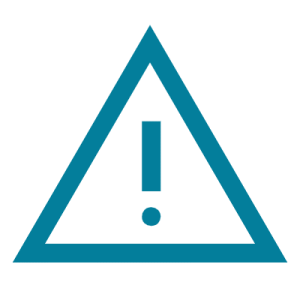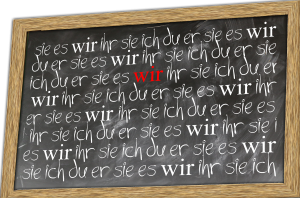5.1 „sein,” „haben” und regelmäßige Verben
Conjugation of “sein” and “haben” in the Present Tense (Präsens)
As in English, these two verbs are used frequently and are irregular verbs.
Click to hear the verbs while you read through the charts.
| sein | to be | haben | to have |
| ich bin | I am | ich habe | I have |
| du bist | you are | du hast | you have |
| er/sie/es ist | he/she/it is | er/sie/es hat | he/she/it has |
| wir sind | we are | wir haben | we have |
| ihr seid | you are | ihr habt | you have |
| sie/Sie sind | they/you are | sie/Sie haben | they/you have |
 Achtung!
Achtung!
One of the biggest mistakes language learners make is to directly translate from one language into another.
For example: How are you? I am good.
You may want to directly translate, which would be wrong: Wie bist du? Ich bin gut.
Correct expression: Wie geht es dir? Mir geht es gut.
Personal Pronouns

Personal pronouns refer to the person or thing which performs the action expressed by the verb. Pronouns stand in for nouns when it is clear who is being talked about. For example, when you want to talk about a person without repeating their name, you use a personal pronoun. You have already seen all these pronouns used in sentences.
- ich (I)
- du (you – informal singular)
- er/sie/es (he/she/it)
- wir (we)
- ihr (you – informal plural)
- sie (they)
- Sie (you – formal singular & plural)
Beispiele
- Welche Sprachen sprichst du? Ich spreche Englisch und Deutsch.
- Joaquin kommt aus Peru. Er kommt aus Peru.
- Olena ist Ukrainerin und Kanadierin. Sie ist Ukrainerin und Kanadierin.
Übung 5.1a
Text Description
-
- Card Text: Ich … Amerikanerin. (sein)
- Card Text: Er … ein Handy. (haben)
- Card Text: Wir … Studenten. (sein)
- Card Text: Emma und Lara … eine Katze. (haben)
- Card Text: Die Sonne … gelb. (sein)
- Card Text: Du … ein rosa T-Shirt. (haben)
- Card Text: Ihr … aus der Schweiz. (sein)
- Card Text: Ich … ein Auto. (haben)
- Card Text: Frau Meier, … Sie aus Deutschland? (sein)
- Card Text: Das Jahr … 12 Monate. (haben)
Answers
-
- bin
- hat
- sind
- haben
- ist
- hast
- seid
- habe
- sind
- hat
Conjugation of Verbs in Present Tense (Part 1)
Here is a list of some of the verbs we have used. Please begin to practice and memorize these verbs. Do you see a pattern? Memorize that pattern as well.
| Pronomen | kommen | wohnen |
leben |
heißen |
sprechen |
| ich | komme | wohne | lebe | heiße | spreche |
| du | kommst | wohnst | lebst | heißt | sprichst |
| er/sie/es | kommt | wohnt | lebt | heißt | spricht |
| wir | kommen | wohnen | leben | heißen | sprechen |
| ihr | kommt | wohnt | lebt | heißt | sprecht |
| sie/Sie | kommen | wohnen | leben | heißen | sprechen |
 Achtung!
Achtung!
The verb stem is the portion of the verb that remains after you remove the “en” ending in the infinitive: komm/en, wohn/en, leb/en, heiß/en, sprech/en.
Conjugation refers to the changing of a verb’s form to express a different person (I, you, he/she/it etc.), number (singular, plural), or tense (e.g., simple present tense/Präsens).
Übungen
5.1b: Choose the correct conjugated form of the verb.
Text Description
- heiße
- heißt
- spricht
- sprechen
- heiße
- heißt
- sind
- bist
- lebt
- lebe
- sprecht
- spreche
- kommt
- kommen
- ist
- bin
- wohnst
- wohnen
- kommt
- kommen
5.1c: Fill in the missing verbs.
Text Description
Fill in the missing verbs in their conjugated form: kommen – sprechen – heißen – wohnen
Dialog A
Andreas: Hallo. Ich _____ Andreas. Wie _____ du?
Monique: Ich _____ Monique.
Andreas: Und woher _____ du? Aus Deutschland?
Monique: Nein, ich _____ aus Kanada. Ich _____ Englisch, Französisch und ein bisschen Deutsch. Welche Sprachen _____ du?
Andreas: Ich _____ Deutsch, Englisch und ein bisschen Spanisch.
Dialog B
Herr Dall: Guten Morgen, Frau Chan. Woher _____ Sie?
Frau Chan: Hallo, Herr Dall. Ich _____ aus China.
Herr Dall: Und wo _____ Sie?
Frau Chan: Ich _____ in Leipzig. Und Sie?
Herr Dall: Ich _____ aus Düsseldorf und _____ zurzeit in Dresden. Welche Sprachen _____ Sie?
Frau Chan: Ich _____ Chinesisch und ein bisschen Deutsch. _____ Sie Chinesisch?
Herr Dall: Ich? Nein! Ich _____ Deutsch und Englisch.
Dialog A
Andreas: Hallo. Ich heiße Andreas. Wie heißt du?
Monique: Ich heiße Monique.
Andreas: Und woher kommst du? Aus Deutschland?
Monique: Nein, ich komme aus Kanada. Ich spreche Englisch, Französisch und ein bisschen Deutsch. Welche Sprachen sprichst du?
Andreas: Ich spreche Deutsch, Englisch und ein bisschen Spanisch.
Dialog B
Herr Dall: Guten Morgen, Frau Chan. Woher kommen Sie?
Frau Chan: Hallo, Herr Dall. Ich komme aus China.
Herr Dall: Und wo wohnen Sie?
Frau Chan: Ich wohne in Leipzig. Und Sie?
Herr Dall: Ich komme aus Düsseldorf und wohne zurzeit in Dresden. Welche Sprachen sprechen Sie?
Frau Chan: Ich spreche Chinesisch und ein bisschen Deutsch. Sprechen Sie Chinesisch?
Herr Dall: Ich? Nein! Ich spreche Deutsch und Englisch.
“1.8” from Willkommen: Deutsch für alle by Claudia Kost and Crystal Sawatzky is licensed under a Creative Commons Attribution-NonCommercial-ShareAlike 4.0 International License, except where otherwise noted.

